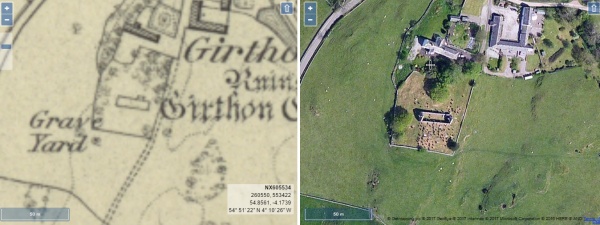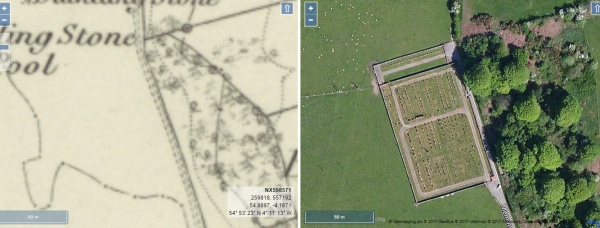Google Street Views
The following two Google street views are of the Old Girthon kirkyard (The church ruin can be seen in the distance) and of the more modern cemetery respectively:
First and Second Statistical Accounts of the Parish
Side by Side Mapping
The website of the National Library of Scotland has a fascinating map viewer. Clicking on the images shown below will open a page showing an early Ordnance Survey map showing the burial grounds alongside a modern satellite view of the same area. Once open, the maps can be scrolled and zoomed and different map combinations can be selected.
Girthon old kirkyard
Girthon cemetery
A TOPOGRAPHICAL DICTIONARY OF SCOTLAND, by Samuel Lewis. Published in 2 vols, London, 1846.
“GIRTHON, a parish, in the Stewartry of Kirkcudbright, 6 miles (N. W.) from Kirkcudbright ; containing, with the larger part of the burgh of Gatehouse of Fleet, 1874 inhabitants. This place, which is of great antiquity, is supposed to have derived its name, signifying, in the Celtic language, an inclosure or sanctuary, from some religious establishment having that privilege, and which existed at a very early period, at the passage of the river Fleet. In 1300, Edward I. of England, during the contested succession to the Scottish throne, resided for several days at the old town of Fleet, now Gatehouse, and presented an oblation at the altar of Girthon : after levying some fines from the town, for the misconduct of the inhabitants, who had attempted to oppose his progress, he retired without further molestation.
The lands anciently belonged to a branch of the family of the Stewarts, from whom they passed by marriage to Donald de Levenax, or Lennox, son of the Earl of Lennox ; and on the death of the seventh lord of Girthon, the estate, together with the family seat of Cally, was conveyed by his daughter, in marriage, to Richard Murray, of Broughton, whose descendant, Alexander Murray, Esq., MP., is the present proprietor.
The parish, which is bounded on the south and west by the bay and river of Fleet, is about sixteen miles in length, and from two to five in breadth, comprising 15,480 acres, of which 4000 are arable, 1000 woodland and plantations, and the remainder heath and waste, affording tolerable pasture for sheep and cattle. The surface towards the north and east is mountainous and bleak ; towards the south, with the exception of some gentle undulations, pretty level. In the mountainous district are several lakes, of which the principal are. Loch Greauoch, about three miles in length, and half a mile in breadth ; Loch Skerroch, nearly half a mile square; Loch Fleet; and Loch Whinnyan, on the eastern border of the parish. From Loch Fleet flows the little water of Fleet ; and this, after a few miles, is joined by the great water of the same name, together making the river Fleet, which, after a winding course, dividing the parish from that of Anwoth, runs into Fleet bay. In Loch Greanoch are found char in great abundance, and pike in Loch Skerroch ; a few salmon are taken in the river Fleet, and flounders in great plenty ; and near the mouth of the river are two small islands, where excellent oysters are obtained. These isles are uninhabited, affording only pasturage for sheep. The SOIL is various : the arable lands, which are under good cultivation, produce favourable crops, and the meadows are luxuriant. The farm-bouses, most of which have been rebuilt, are substantial and commodious ; and all the more recent improvements in husbandry have been adopted. The cattle, of which about 1200 are annually reared, are of the Galloway breed; and the sheep, of which 8000 are fed in the mountain pastures, are of the small native kind. The rateable annual value of the parish is £5698.
There are considerable remains of ancient woods at Castramont and a few other places ; and the plantations of more recent date are in a thriving condition. The substrata are chiefly clay-slate and granite, of which latter the rocks are principally composed. A slate quarry was some years since in operation, but has been superseded by the importation of slate from England and Wales, at a cheaper rate ; and a vein of copper-ore, which was formerly wrought by a company from Wales, has been also discontinued. The principal mansion is Cally, the seat of Mr. Murray, a spacious and elegant structure of granite, erected in 1763, and since much improved ; it contains a noble hall of marble, in which are some handsome pieces of sculpture, and has many stately apartments, with valuable paintings. The pleasure-grounds and gardens are extensive and tastefully embellished, and in the park are numerous herds of deer, and some fine specimens of the ancient Caledonian breed of cattle. The ecclesiastical affairs are under the superintendence of the presbytery of Kirkcudbright and synod of Galloway. The minister’s stipend is £158. 6. 8., with a manse, and a glebe valued at £20 per annum ; patron, the Crown. The church, situated at Gatehouse, is a neat substantial structure, erected in 1818, and contains 714 sittings. The members of the Free Church have a place of worship. The parochial school is attended upon the average by ninety children : the master has a salary of £45, increased to that amount by Mr. Murray, with a house and garden ; and the fees average about £40 per annum. A charity school is supported by Lady Anne Murray, in which the children are gratuitously clothed and instructed. The site of the palace of the bishops of Galloway is still pointed out here, though there are no vestiges of the building; and in the pleasure-grounds of Cally are the remains of the ancient family seat. There are several small moats, called ” Doons,” and also an ancient camp, forming one of a line which traverses the Stewartry.

